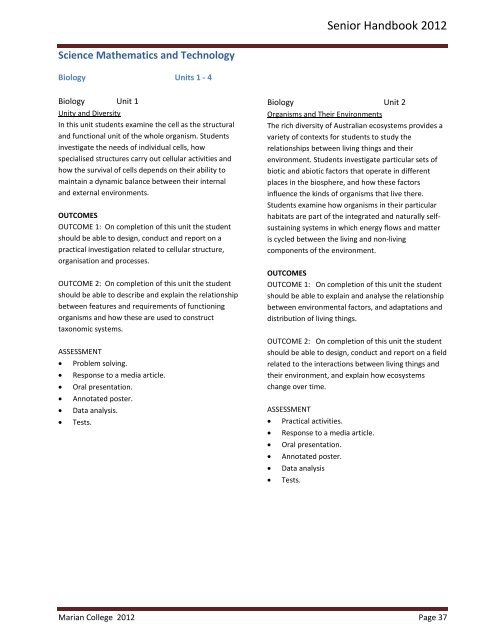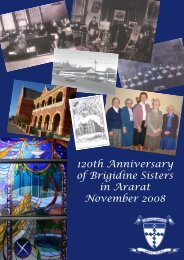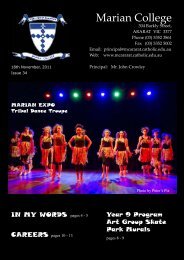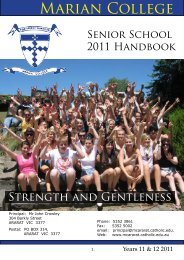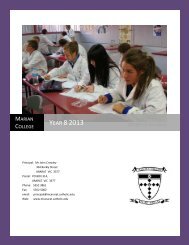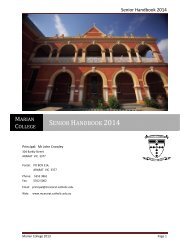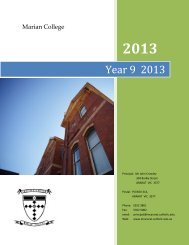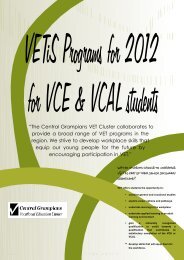Senior Handbook 2012 - Marian College
Senior Handbook 2012 - Marian College
Senior Handbook 2012 - Marian College
Create successful ePaper yourself
Turn your PDF publications into a flip-book with our unique Google optimized e-Paper software.
<strong>Senior</strong> <strong>Handbook</strong> <strong>2012</strong><br />
Science Mathematics and Technology<br />
Biology Units 1 - 4<br />
Biology Unit 1<br />
Unity and Diversity<br />
In this unit students examine the cell as the structural<br />
and functional unit of the whole organism. Students<br />
investigate the needs of individual cells, how<br />
specialised structures carry out cellular activities and<br />
how the survival of cells depends on their ability to<br />
maintain a dynamic balance between their internal<br />
and external environments.<br />
OUTCOMES<br />
OUTCOME 1: On completion of this unit the student<br />
should be able to design, conduct and report on a<br />
practical investigation related to cellular structure,<br />
organisation and processes.<br />
OUTCOME 2: On completion of this unit the student<br />
should be able to describe and explain the relationship<br />
between features and requirements of functioning<br />
organisms and how these are used to construct<br />
taxonomic systems.<br />
ASSESSMENT<br />
• Problem solving.<br />
• Response to a media article.<br />
• Oral presentation.<br />
• Annotated poster.<br />
• Data analysis.<br />
• Tests.<br />
Biology Unit 2<br />
Organisms and Their Environments<br />
The rich diversity of Australian ecosystems provides a<br />
variety of contexts for students to study the<br />
relationships between living things and their<br />
environment. Students investigate particular sets of<br />
biotic and abiotic factors that operate in different<br />
places in the biosphere, and how these factors<br />
influence the kinds of organisms that live there.<br />
Students examine how organisms in their particular<br />
habitats are part of the integrated and naturally selfsustaining<br />
systems in which energy flows and matter<br />
is cycled between the living and non-living<br />
components of the environment.<br />
OUTCOMES<br />
OUTCOME 1: On completion of this unit the student<br />
should be able to explain and analyse the relationship<br />
between environmental factors, and adaptations and<br />
distribution of living things.<br />
OUTCOME 2: On completion of this unit the student<br />
should be able to design, conduct and report on a field<br />
related to the interactions between living things and<br />
their environment, and explain how ecosystems<br />
change over time.<br />
ASSESSMENT<br />
• Practical activities.<br />
• Response to a media article.<br />
• Oral presentation.<br />
• Annotated poster.<br />
• Data analysis<br />
• Tests.<br />
<strong>Marian</strong> <strong>College</strong> <strong>2012</strong> Page 37


